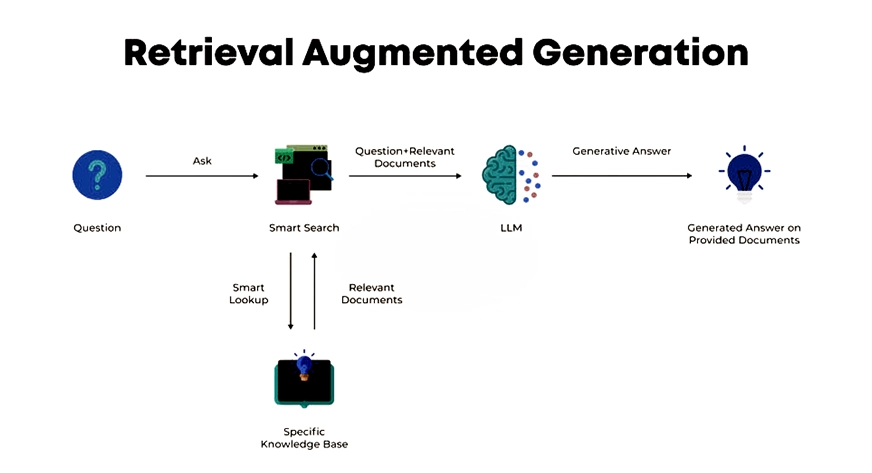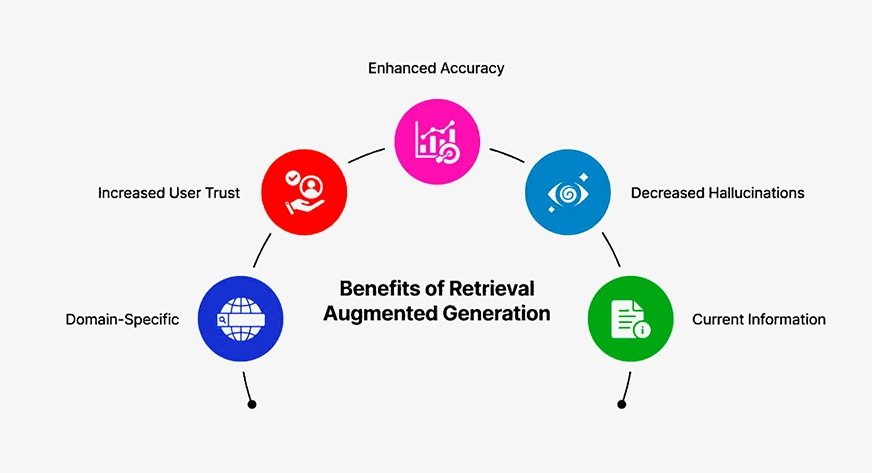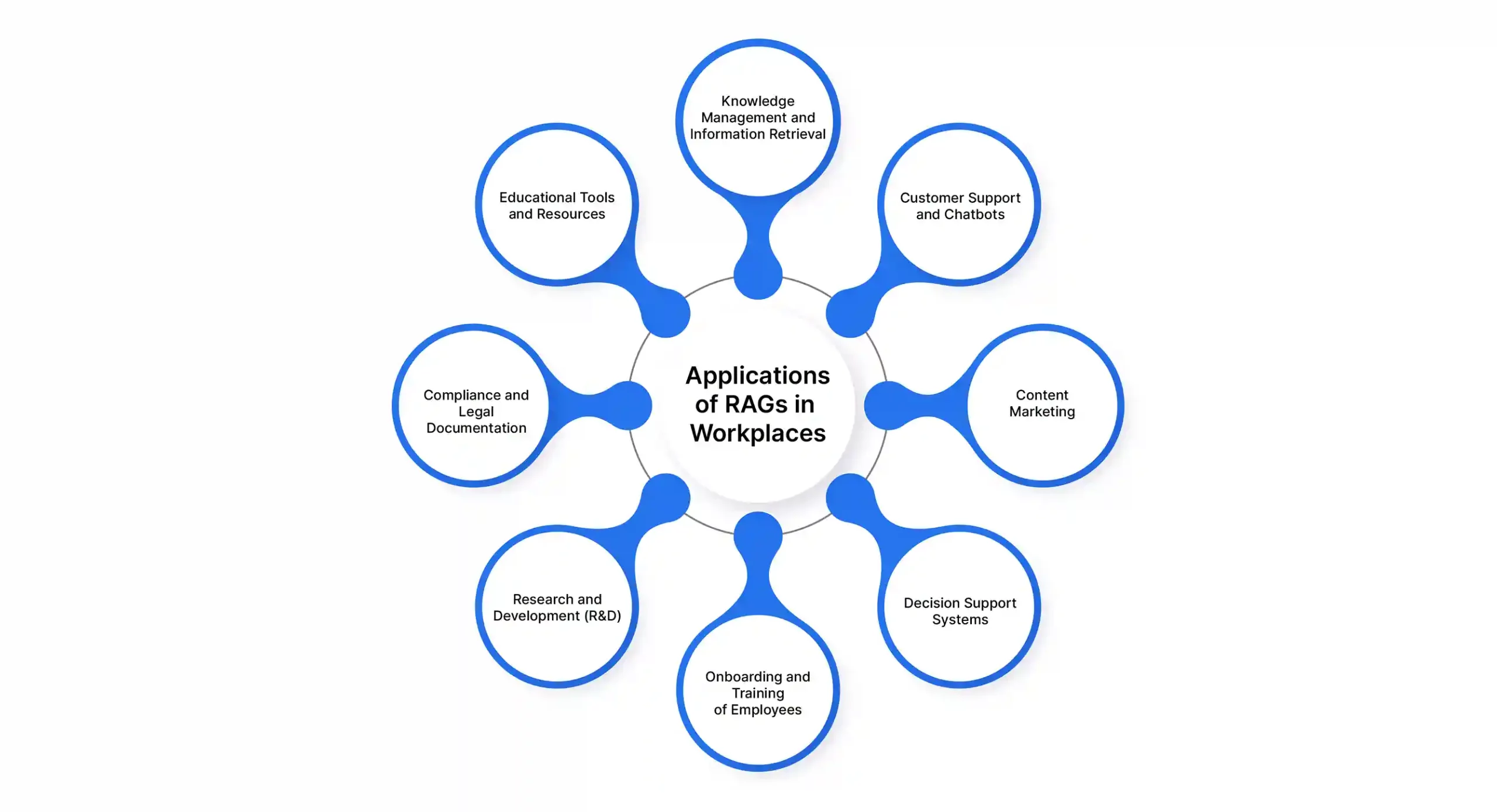Introduction
Retrieval-Augmented Generation (RAG) is one of the most exciting recent innovations in artificial intelligence (ai). RAGs combine the power of generative models, like GPT, with a retrieval system that searches for relevant information in real-time. This makes them highly effective tools for various job roles across various industries. Whether you’re a data scientist, a content creator, a business head, a manager, a CEO, or a lawyer, RAGs can help you streamline workflows and enhance decision-making. They can provide you with valuable insights and transform the way you work. In this article, we will explore some of the many applications of RAGs in various workplaces.
Overview
- Understand what RAGs are and how they work.
- Explore the various applications of RAGs in the workplace.
- Know the common challenges faced while using RAGs in the workplace.
- Learn the best practices to follow for effectively deploying RAGs.
What are RAGs?
RAGs are ai models with the combined capabilities of retrieval-based systems and generative ai (GenAI). These powerful hybrid models pair a generative model (like GPT-4) with a retrieval mechanism (such as a search engine or database). While GenAI models like Gemini can create text-based outputs from scratch, RAGs can also retrieve external data during generation. This makes the generated output more accurate, relevant, and contextually aware.

RAGs can pull information from structured and unstructured databases, documentation, or the web and integrate it seamlessly into responses. In an organizational context, this becomes very useful to get highly informed responses, unlike standard GenAI models, which rely only on pre-trained data. They can revolutionize how organizations handle knowledge management, customer support, decision-making, and more at the workplace, significantly improving productivity and efficiency.

Today, RAGs are incorporated in organizations across various fields, from data science and marketing to legal and healthcare. Let’s explore how each of these fields is making the best use of RAGs in its workflows.
Also Read: 5 Days Roadmap to Learn RAG
Top 8 Applications of RAG Systems in Workplace
RAGs have the ability to enhance efficiency, improve accuracy, and reduce time spent on manual research, making them more and more important in organizations. Here are some of the most useful applications of RAGs in different departments and job roles:

1. Knowledge Management and Information Retrieval
In organizations, employees often need to sift through vast documents, reports, and data to retrieve relevant information. RAG systems can automate and streamline this process by generating concise summaries or detailed responses based on real-time retrieval of internal or external databases.
At the enterprise level, RAGs can integrate different knowledge bases to provide employees comprehensive information across departments. In healthcare, RAGs assist medical professionals by retrieving research papers and helping in diagnosis and treatment planning. In data science and data analytics, RAGs can help retrieve relevant research papers, statistical models, and datasets to provide context or background for specific problems.
Example Use Case:
A company with a large repository of project documents and reports could use RAGs to answer employees’ natural language queries. For instance, team members could ask questions like “Give me a list of current projects in my department ” or “What is our company’s policy regarding engaging external consultants?” The model can retrieve relevant documents, summarise the content, and generate a coherent answer to the queries.
2. Customer Support and Chatbots
Customer service is one of the most prominent applications of ai, and RAGs take it to the next level. They create chatbots that can provide more accurate and contextually appropriate responses. Unlike standard ai chatbots that rely solely on pre-programmed responses, RAG models dynamically retrieve information to create relevant and up-to-date responses.
ai agents powered by RAGs can help customer service representatives by retrieving policy documents, product information, and customer interaction history in real-time and providing informed responses to complex queries.
Example Use Case:
Thomas Reuters, a leading business information and content technology provider, uses a GPT-4 powered RAG-based chatbot to help its customers make better decisions. It has proven to be an efficient, cost-effective solution that doesn’t hallucinate much, making it better than ai.
3. Content Marketing
Marketing professionals use RAGs to streamline their market research process and develop marketing strategies based on the research. They also draft and optimize marketing content based on the latest industry trends and statistics retrieved from trusted industry databases.
Example Use Case:
A marketing team’s RAG model can assist in drafting email campaigns or developing content plans. The model could retrieve data from previous successful campaigns, industry reports, and market research to generate targeted content that resonates with customers.
4. Decision Support Systems
Managers and decision-makers often need access to up-to-date information from various sources to make informed decisions. RAGs can provide a consolidated view by retrieving data from multiple channels, summarizing it, and presenting actionable insights. This reduces the time spent on research and offers a holistic view of strategic decisions.
Example Use Case:
A financial analyst could use a RAG-powered system to pull in data from market trends, competitor reports, and internal financials, then generate a report that assists the company’s executive team make strategic investment decisions.
5. Onboarding and Training of Employees
Onboarding new employees and training existing ones can be complex, especially in large organizations with vast amounts of knowledge. RAGs can support HR and training departments by retrieving key information and generating personalized training content.
RAGs can also provide employees with instant, context-specific answers during their training or day-to-day work, reducing their dependency on supervisors. Moreover, these systems can gather information from an organization’s knowledge base and external sources to create customized training materials for different roles or skill levels.
Example Use Case:
An example of an application of RAG in a workplace is a manufacturing firm might implement an RAG model to obtain data from safety guidelines, equipment manuals, and internal SOPs to generate personalized handbooks for new employees. This will ensure they have all the necessary information to start work safely and efficiently.
6. Research and Development (R&D)
For companies in R&D-heavy sectors like pharmaceuticals, technology, or engineering, RAGs can assist in retrieving research papers, patents, technical documentation, and more. Instead of manually combing through countless papers and documents, RAGs can retrieve and summarize key findings. This would accelerate the research process and allow researchers to focus on innovation.
They can also generate insights from these sources, helping researchers stay up-to-date with the latest developments in their field. Moreover, since RAGs can integrate information from various fields, they can assist in finding novel insights that may not be apparent from a single discipline.
Example Use Case:
A pharmaceutical company could use a RAG-powered tool to scan the latest medical research on a particular compound. The tool can pull out key findings and generate a report highlighting the potential benefits and risks for further investigation.
7. Compliance and Legal Documentation
In industries where compliance and legal documentation are important, RAGs can help ensure that companies are always up-to-date with regulations and legal standards. They can pull real-time data from regulatory bodies and legal sources to keep compliance teams updated on the latest changes.
They can retrieve relevant legal texts, regulatory guidelines, and compliance documents, generating summaries or flagging important updates. Thus, businesses can use RAGs to avoid legal pitfalls by quickly generating summaries of relevant laws and regulations.
Legal professionals can also leverage RAGs to retrieve case files, legal statutes, and articles relevant to a particular legal issue, making research faster and more accurate.
Example Use Case:
An example of an application of RAG in a workplace is law firms handling mergers and acquisitions. Lawyers can use RAGs to access and summarize past company documents to draft better contracts. RAG systems can also be used to find examples from the past for copyright lawsuits.
8. Educational Tools and Resources
RAGs play a pivotal role in creating interactive learning environments by retrieving relevant materials and generating educational content in the education and corporate training sectors. This can greatly enhance e-learning platforms, corporate training programs, and self-learning environments by providing personalized learning paths and real-time explanations.
An online learning platform could leverage RAGs to generate personalized study guides or lesson summaries for students. When a student struggles with a specific concept, the model can retrieve relevant tutorials, articles, or exercises, providing tailored assistance in real-time.
Example Use Case:
Anna University developed a RAG-based ai chatbot trained on their entire engineering syllabus to help students find answers quickly. Students can ask the bot questions on any topic within the syllabus, and the chatbot will give concise answers after referring to textual data from various textbooks.
Also Read: Building GenAI Applications using RAGs
Challenges of Using RAG at Work
While RAGs offer immense potential in making work easier, they do come with a few challenges:
- Data Privacy: RAGs rely on accessing vast amounts of data, which may include sensitive or proprietary information. Thus, managing data privacy and security becomes critical.
- Accuracy: The retrieval system may pull outdated or irrelevant information, affecting output quality.
- Bias: RAGs, like other ai models, may perpetuate biases in the data they retrieve or generate. This could lead to skewed results or misinformation.
- Integration Issues: Seamless integration with existing systems and workflows can be challenging, especially in large organizations with complex IT ecosystems.
Best Practices for Using RAG Systems at Workplace
Here are some best practices to follow while using RAGs at your workplace:
- Data Quality Assurance: Ensure RAG systems retrieve data from trusted, up-to-date sources to improve accuracy and reliability.
- Human Oversight: While RAGs can automate tasks, human supervision is necessary to verify the output, especially in critical areas like healthcare and law.
- Data Security: Robust security protocols must be in place to protect the sensitive information accessible to RAGs.
- Bias Mitigation: Incorporate techniques to minimize bias in retrieved and generated content to ensure fairness and inclusivity.
Conclusion
RAGs are revolutionizing job roles across various industries with their application in the workplace. They provide real-time access to valuable information and enable more informed decision-making. From legal research and content optimization to customer support and fraud detection, RAGs are streamlining workflows and enhancing productivity. However, they do come with their set of challenges, including data privacy and accuracy issues. By adhering to best practices, organizations can harness the full potential of RAGs while mitigating risks.
As organizations adopt ai-driven solutions, RAG will likely play an integral role in automating and optimizing workplace processes. This will allow employees to focus on higher-value tasks that require creativity, critical thinking, and human judgment.
If you want to learn more about RAG, checkout our GenAI Pinnacle Pro
gram today!
Frequently Asked Questions
A. RAGs are ai models that combine the capabilities of generative ai with relevant data retrieval to provide more accurate and contextually relevant responses.
A. RAGs provide up-to-date information and enhance decision-making across data science, legal research, and customer support.
A. The primary challenges include data privacy concerns, the potential for inaccurate or outdated retrievals, and integration difficulties within complex organizational systems.
A. RAGs are highly effective in industries such as healthcare, legal, marketing, customer service, and data science, where a lot of external and internal data is referred to to make informed decisions.
A. RAGs are designed to augment human capabilities. They may reduce the reliance on humans for some tasks, but there will be a demand for human subject matter expertise. RAGs can assist with tasks like data retrieval and content optimization, while humans provide oversight and context.
A. Implementation of RAGs in a workplace can be challenging due to the need for integration with existing systems and ensuring data security. However, with the right strategy, the benefits outweigh the complexities.
 NEWSLETTER
NEWSLETTER






